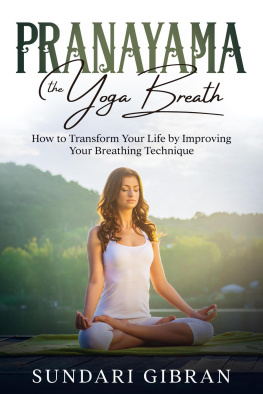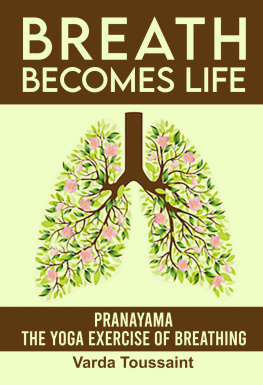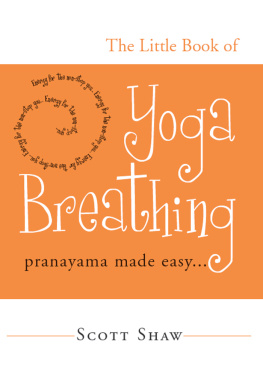
PRANAYAMA
PRANAYAMA
The present book introduces us intelligently to the
The present book introduces us intelligently to the
basic breathing practices and describes the
basic breathin g practices an d describe s the fundamental aspects of their psycho-physiology. This is meant for the people who are following a hectic life in the worl d of constan t an d fast changin g surroundings . This will hel p to experience with their own breath consciously to bring a harmonious balance in their constitution of the body, mind and soul and thereby getting tranquility, inner satisfaction and confidence in their life.
This may prove panacea to peopl e wh o are
weary of their restless activities and longing for
weary of their restless activities and longing for
inner peace, an inborn desire of the soul, a spiritual
inner peace, an inborn desire of the soul, a spiritual
heritage of human beings. Further may help toheritage of human beings. Further it may help to
build a bridge between the internal and external
build a bridge between the internal and external life to maintain balance and harmony in between positive and negative aspects of life.


My Guru Sri Bishnu Charan Ghosh (1903-1970) Master of Yoga and Physical Culture Younger brother of Paramahansa Yogananda
Note: In India since ages it was a ritual tradition for Yogis to meditate sitting on tiger skins to achieve the mystical power, before the awareness on extinction of tiger appeared in human consciousness. Nowadays mostly the deerskins are used for meditation and other ritual purposes.
PRANAYAMA PRANAYAMA
A Conscious Way of Breathing
RANJIT SEN GUPT A

XeaJ 71!1e 2JOO~.Jks
Dedicated toMy Guru late Sri Bishnu Charan Ghosh
and
my dear father late Sri Sachindra Mohan Sen Gupta.
They both gave me the insight in Yoga and formed my character. Their loving presence was my ideal and that will remain for ever.


Foreword*
Foreword*
Pranayama is the conscious perception and guidance of life energies which unfold self in complex form in the psycho-physical system of all living beings. Pranayama is thus more than a system of breath control. Pranayama has several aspects, in the coarse material body and in the fine material body, directly perceptible ones and more subtly hidden ones.subtly hidden ones. Prana manifests itself in body movements, in the metabolism, in sexuality and in all conscious procedures, and shows itself particularly clearly in the act of breathing. All great nlltuf3llraditions of mankind h:tH' :Ull:IS$\,:d a fund of experimentalcultural traditions of mankind have amassed a fund of experimental knowledge of correlations between body and soul particularly evident in the function of breathing. The act of breathing is therefore the easiest accessible connecting link between vegetative functions and mentally guided procedures, because it is involved in both spheres: we breathe as long as we live - in fact, life means breath. Even when we are unconscious, we continue to breathe. However, at the same time the act of breathing can also be subdued under UlIlSci(IUS pt'ltI.-'pti(lll and ).:uidancl:'. Thus, thl:' entire psychophysical system, including the subconscious activities, can be brought into balance and harmony by consciously directed way of breathing.
into b:l!aIlO: alld h:mnony by consciollsly directed way of bre:lthing,
PrJn:lyam:1
Pranayama is the central practice of Yoga.
is the cenll:ll pral"lice of Yoga.
Yoga is a philosophy of life. It is a matter of perfect practice and co-ordination of three levels of activity: Physical, psychic and material, with the key to success being the exact coordinated practice of these three levels. This has an effect on one's philosophy
of life. The dualism l)l:'!ween hody and mind or even the rt'dueing
of life. The dualism between body and mind or even the reducing
of the human heing on till' ll:'vel of physiologically explainable and
of the human being on the level of physiologically explainable and
mech:lllkally illterprl'll'd prlX'l'dures do correspond neither with the
mechanically interpreted procedures do correspond neither with the theory nor with the practical expl'riello:s of Yog:l. The is totheory nor with the practical experiences of Yoga. The aim is to intluence the physical kvel I)y rllental pf(ll:es.<;es (concentnltion,influence the physical level by mental processes (concentration,
. Origin:,ttc;Ihc' :lulh"r.
\iii .:. Pr.m;/Fmw _
attentiveness), which in turn stabilize the mind. Thus with the mind resting in absolute tranquility, it is no longer subjected to the stimuli previously provided by the senses. The mind becomes "transparent", becomes absorbed in itself and reaches a self-knowledge which would not be possible in our general consciousness, when we are busy reacting sensual stimuli or thinking about past experiences. This is where the function of breathing plays a crucial role. By careful and exactly co-ordinated ways of breathing we release psycho-physical reactions, which prove man to be a continuance of body and mind. Physical and mental imbalances can thus be overcome and be integrated and the person can be healed in mind and body.and body.
Nowadays in the West, too, there are authentic Yoga teachers and exct:lkm courses and a host of literature available which allowsand excellent courses and a host of literature available which allows to go on the path of Yoga in an acceptable way that suits the western ways of life. The presented book introduces us intelligently to the basic breathing practices and describes the fundamental aspects of their psycho-physiology. With th:mks deserving accuracyaspects of their psycho-physiology. With thanks deserving accuracy the author provides the necessary core information. It is true that Pranayama can only be achieved through practical training under the guidance of a competent teacher. However, this written text presents a necessary first orientation and it will also prove to be perpetual helpful to the advanced students on the way to practice.
Munich, in November 2001
Michael von BruckckPreface to the Second Edition
Preface to the Second Edition
This book brings to the reader the age-old techniques of Pranayama. It is a belief in yoga that the length of one's life is measured by the
destined number of breathing one does in one's life period and not
just by years or days. In Pranayama then one can diminish the breath
frequency (number of breath done per minute) and that causes the
stretching of the life span.
Yogis achieve the peace of mind by controlling their breath through
Pranayama practice.
By regular practice of Pranayama we achieve a deep consciousness
of our own breath, our constant companion of us from birth to death.
Next page










